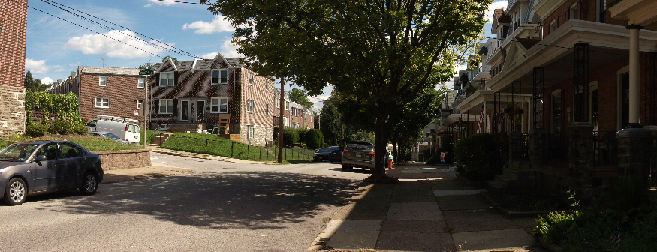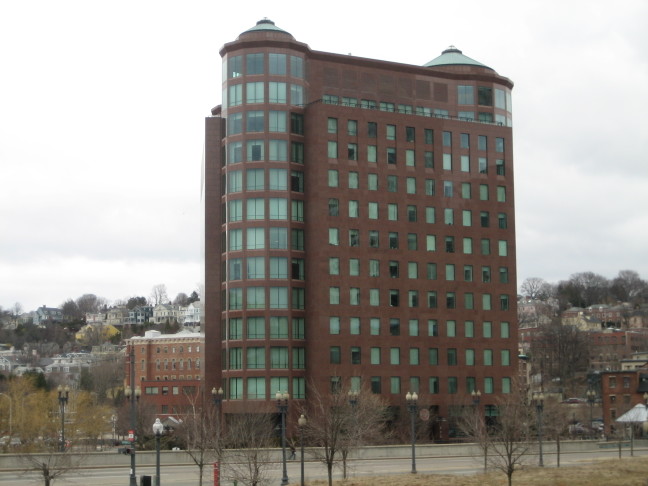Like any good dogmatist, Hayek recently
disparaged Keynes. Yet he without sin casts the first stone: perhaps he should try and clean his own house first.
It was precisely those qualities Hayek disparaged Keynes for that made Keynes a good economist.
The fact of the matter is that economics as a discipline has advanced little since Smith's
The Wealth of Nations, and the person who singlehandedly offered the most advancement was, in fact, Keynes. This is not to say he was all right--indeed, as Jane Jacobs points out, Keynesianism's principal quantitative instrument, the
Phillips curve, had begun to fail as early as 1967,* and his economic corpus left no theory adequately explaining the onset of stagflation a decade thereafter. But when Keynes, a trained mathematician, turned his eye to economics, the field had already rotted away from a century or more of disciplinary decadence, laid bare by the Great Depression's onset. In short, Keynes was a talent in one field who turned his attention to an adjacent one--the paragon of an innovator.
This is not to defend post-1970s neo-Keynesians. Despite the volley between them, the Austrians, and the latter's successor neoclassicals,
none of them have offered any real solutions, and
all of them have offered a mix of rehashed masters' theories, bullshit, and (in very rare moments of clarity) insights. Nor has the neoclassical's fixation on mathematical modeling helped: many of their "sophisticated" models are actually very elementary, almost childish, applications of iterated operations. And anyway, a model is like a program, and as the programmers like to say, "Garbage in, garbage out".
Perhaps nuggets of wisdom can be found in neoclassicals' pesudomathematical clutter,
but so much of the discipline is fundamentally deficient that no matter how mathematically accurate the models may be, they will never return anything more than garbage. Something is rotten in the state of Denmark. Stagflation laid this bare; it was papered over; 2008 laid it bare again. Jacobs offered the single most accurate critique of the economics of her day in 1984; for a generation, it has been ignored. But sooner or later, the reckoning must come, and when it does, I hope that the offer below does some good.
Some Major Fallacies and Other Rational Lapses
Hayek's Fallacy. This one is named after Friedrich Hayek, doyen of the Austrian School. Hayek is credited for several important insights--but this fallacy is closely tied to his realization that economics is both a
complex and
self-organizing system. More a philosopher at heart, Hayek found himself without the wherewithal to deal with the problems at hand, and much of his work is thus a demonstration of the limits of qualitative analysis in economics.
But the real issue comes--and this is why the neoclassicals break from the Austrian School--when Hayek, whose work lies at the very edge of qualitative reasoning's capabilities, becomes suspicious of those attempting to find and apply mathematical instruments to the problems at hand.
Basically, Hayek's Fallacy amounts to an economist (or a scientist of any sort) doing one of two things: either (a) throwing one's hands up in the air and saying "I give up!" when faced with the understanding that a system is too complex to
easily be soluble (or at least tamable), and/or (b) embracing that complexity as a thing-in-itself instead of further teasing it apart, finding the internal feedbacks, etc.
For example, a thinker, when faced with the realization that System A is a integrated dynamic agglutinated supersystem over System B, engages in Hayek's Fallacy if he fails to further attempt to find the underlying integrations and agglutinations, or tease apart its dynamics. In rhetoric, Hayek's Fallacy can function as a call-to-arms, a statement that a problem is too big for one mind to solve; it, however, has no place in academic literature.
Smith's Mistake, or,
The Anthropological Fallacy. This is the fallacious conflation of
nation and
state in economic literature. Recall that the definition of a
nation is "a people, race, or tribe; those having the same descent, language, and history," whereas a
state, in all of its forms, is simply a statement of political sovereignty.
As Jacobs put it, "[Smith] accepted without comment the mercantilist tautology that nations are the salient entities for understanding the structure of economic life"**. But
this very tautology is a confusion between "nation" and "state", brought about by a misreading of the special case of Enlightenment Europe. She herself sidesteps this issue:
nation in
Cities and the Wealth of Nations is actually used in contexts that imply "state" (as it is in Smith's work), and is indeed often paired with "sovereignty".
This confusion has never adequately been addressed in the literature, which is a shame really, because
The Wealth of Nations is actually exactly what it says on the tin ... at least until Smith starts discussing issues that apply to the
state, not the
nation. But the sovereign macroeconomics*** it supports is thus, by definition, a very small subclass of sovereignties--nation-states.
How many of them can you name? In fact, even some of the strongest candidates for nation-statehood, like France, constitute cultural empires^: France includes France proper, Brittany, Languedoc except for the part of Savoy that ended up in Italy, about half the Basque Country, part of the Rhineland aka Alsace, and possibly a little tiny part of Catalonia that ended up on the wrong side of the Pyrenées. About half Germany's
Länder are little tiny nation-statelets. Ignoring Northern Ireland, the UK has about half a dozen nations: Scotland, Wales, Cornwall, the Isle of Man, and at least two distinct Englands. Spain includes the nations of Aragon, Andalusia, Castile, Catalonia, Galicia (which is really a northern extension of Portugal), and the other half of Basque Country. Venice, Milan, Genoa, Florence, Rome, Naples, and Palermo are all culturally
very different places, anchoring very different places. And so on. So even on a continent where the political boundaries come closest to matching nation-states, they rarely ever are.
What do you think this implies for truly large states?
The Energy Golden Calf. A faulty premise underlying a great deal of modern macroeconomics. It is often claimed that, due to the advancement of our economy, energy inputs have decoupled. Not just utter bullshit--the fact that
energy crises can be shown to underlie both the 1970s and 2008 recessions alone should tell us as much--but dangerously ethnocentric, to boot.
Funny Money. This is the idea that modern monetary theory (much of it based on fiat currency) has solved everything. In reality, it ignores the underlying problem--limits to growth, particularly viz. debt's role in demanding growth--and allows us to, instead of solving these very real problems, paper them over with nice-sounding bullshit like the Energy Golden Calf or the idea that Bakken and Eagle Ford will make us energy-independent.
While gold bugs are mistaken in holding a metal's value sacrosanct (the natural conclusion of
this post is that there is a very real natural money base, and it ain't metal), the fact that they dare question Funny Money dogma--one that especially pervades finance--deserves some credit in and of itself.
Politics Overassignment. An outgrowth of the failure to fix Smith's Mistake, the belief that the sovereign state is the arbiter of macroeconomics often leads economists of all types to assign outsize roles to these entities' politics. But the point of Smith's Mistake is that the sovereign state is
not macroeconomics' arbiter! Why, then, should its politics be anything but tangential to (if not a derivative of) its economic well-being?
I have a "razor", a corollary of this mistake. In any given explanation of an economic phenomenon, the one that utilizes politics the
least is usually the correct one.
Major Unaddressed Problems
The Growth Problem. Nearly everything in economics is predicated on infinite growth. As any hard scientist will tell you, however, nothing is. This core problem, ignored in most schools of thought, and aggressively denied and papered over in the few that even consider it, refers to the need to reconcile economic health and well-being with an environment that is less than tolerant of infinite growth. This issue manifests in several tight-knit issues:
- The Debt Problem. A simple explanation of debt is a good advanced now, paid back later. It, in other words, adds a temporal element, a half a dimension, to the system. The problem is that, in the financial system that has supported the industrial economy, debt is advanced only with interest: Not just an advance in the now, but pay back with a little extra later. Growth is required to pay that little extra--or--Interest demands growth. But since it is precisely this interest which grows the money supply, this implies that Money demands growth. The inescapable conclusion of this is that due to its debt-and-interest foundation, money is not resilient to a lack of growth, and hence unsustainable. But debt is required in any healthy economy, growth or not! This in turn demands that (a) the money base be removed from the debt base, and (b) the debt base managed so that it does not overshoot its limits. Current economic theory is blind on the latter--infinite growth is orthodoxy--and hence fails to understand the underlying issues that enforce the former.
- The Energy Problem. Energy is the key economic input. Without energy, an economy can't function. While the Energy Golden Calf and Funny Money chronicle the fallacious attempt at decoupling it, it is a certainty that a world with limits is going to have to deal with the this issue sooner or later.
- The Economic Health Problem. If a healthy economy is predicated on infinite growth, how can one with no growth be achieved? And second, if it is possible to have a healthy economy without meaningful growth, how would it have the most equitable distribution of goods?
The Imperial Problem. Pursuant to Smith's Mistake and its attendant Politics Overassignment, the dominant issue in the
branch of macroeconomics that focuses on states--sovereign macroeconomics***. While urban, regional, and national economics are relatively well explained, Smith's Mistake has left a key problem with moving from a national level to a state one unanswered. This problem is:
How do imperial economies actually behave? For sovereign macroeconomics to have any real meaning, and any real policy input, answering this question is key, as nearly every sovereign entity is an empire^, and while Jacobs offers significant explanatory inroads, her city-and-region focus would need to be scaled up to find relevant causal and feedback relationships.
The National Problem. The
second largest outstanding problem in sovereign macroeconomics. Briefly stated: Stripping away statist elements, Smith's is an excellent account of the economies of nations; Jacobs complements that with one of cities and regions. It appears fairly evident that a nation without economic centralization--that is, a single major economic hub aka a large city--is a bypassed place^^--but this demands the questions: If cities and regions, and nations are both well-described, then how exactly does a city and region economy give rise to a national one? And if bypassed places are nations that never developed cities, what causes the catalyzing feedback to fail?
The Markets Problem. The role of the market is paramount in economics. Economists of various schools assign various values to this role, but they
all assign
a value to it. But it can clearly be seen that, while the market provides for the optimal allocation of resources in most instances, it fails to in at least two types of (related) cases: the
tragedy of the commons, and
Braess's Paradox. Both of these involve optimal decisions at the
individual level--the level of markets--resulting in suboptimal outcomes at the
communal level--the level of government. Thus it can be seen that,
contra certain schools of economic thought, markets can and often do fail as optimizing mechanisms. The problem is hence: Can we identify which venues markets fail to optimize for? If so, are optimal solutions understood? Can we implement optimal solutions (e.g. with policy)? and finally, Can we build an economic theory that accounts for
both when markets are successful
and when they are failures? Understanding markets limits is the heart of the Markets Problem^^^.
Conclusion
Between the plethora of lapses in thought and problems blinkered dogma leaves unpondered, is it any wonder that the field of economics is becoming ever more marginalized, much of its previous sway now being intruded on by mathematicians whose models are orders of magnitude more sophisticated, or by finance majors handling Wall Street administration? The field is a flailing colossus, its own extreme disciplinary decadence eating away at it from the inside, its fortified silos and walls refracting fresh innovations and insights from the outside like so much enemy artillery.
Despite its PR'd veneer, its inside has become laughable, worse than pseudoscience--a series of entrenched, never-changing dogmatic positions sniping away at each other and disregarding any fresh insight any Other has to offer. It calling itself the "hardest" soft science is worse than a bad joke: The tripe coming out of economics builds mental blocks against insights from other soft sciences (particularly history and anthropology) and plays an outsize role in the soft sciences' marginalization
as a whole. Economics is a cancer in our midst.
And the blogosphere has laid it bare! Before, the walls of academia hid it; today, however, half the economics blogs consist of Keynesians sniping at Austrians, and the other half Austrians sniping at Keynesians, both sides regarding the other with the sort of undisguised contempt you rarely ever see outside of crusaders and jihadists (really the same thing). Then they prognosticate with pearls of wisdom from their masters, and when they invariably turn out, in some way, wrong, spin and backfill them. Blogs like
Naked Capitalism and
Zero Hedge are good for lots of things, but--just like their discipline--are failures in their stated purpose. It is hard to have any sort of productive discussion with economists, or even economics attachés, when the discipline's core is so riddled with errors, and the practitioners so inflexibly defensive, that gentle prodding only ever yields being shouted out.
Is it any wonder I find
engineering more accessible?
___________________
*
Cities and the Wealth of Nations, Ch. 1, pp. 17-20.
**
ibid., Ch. 2, p. 50.
***That is, macroeconomics at the sovereign-state level.
^Here I am using a very "tight" definition, where an
empire means any state that encompasses two or more whole nations. States we often think of as empires can be thought of as
large empires, with ten or more constituent nations. The United States, for example, has about a dozen major nations.
By the way, Europe isn't devoid of nation-states. Off the top of my head: Austria, Slovakia, Hungary, the Czech Republic, the Netherlands and Baltic States, Finland, Scandinavia, Iceland, Portugal, and Malta are all, for all intents and purposes, nation-states.
^^
ibid., Ch. 9, pp. 124-34.
^^^I'd like to further note that solving the Markets Problem might be the single most important contribution economics has to adapting to a world without limits. Growth dogma assumes
there is always more out there, but as is regularly pointed out, this is fallacy. Instead a real solution of the Markets Problem would (should) entail a solution to this question:
How do we tap common resources in such a way that we always leave an adequate amount for those who follow? Back at the dawn of the Industrial Revolution, such a question would have been nonsensical; today, it's a requirement.








































